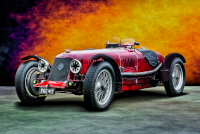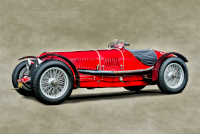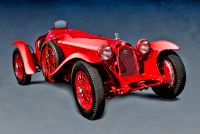Location:
St. Michaels Concours d'Elegance, 2008
Owner: Willem Van Huystee (late) | Lancaster, Pennsylvania
Prologue:
Note that #3004 sold to a new owner in 2016.
An old pair of images to pull out of the stock, #3004 is a significant car, a roadable version of the Grand Prix works car developed from 1931 to 1933, of which Maserati built only two complete cars for certain.
However, as it is built from original components, this car also demonstrates a more original mechanical configuration than either of the two surviving works cars (#3001 and #3002). Of course Maserati developed those works cars in period, so they quickly became improved versions of their original selves.
Hence the value of working with available parts. We then receive a lovely cycle-fender variant, which is perfect juxtaposition for the Alfa Romeo 8C Monza. In this case, the Maserati is more of a Grand Prix car than all-rounder, but both signal the transition point from the biposto to the monoposto.
- - - - - - - - - -
► Image Source: Nikon D200 (10.2 MP)
References:
- Cancellieri, Gianni; Dal Monte, Luca; De Agostini, Cesare; Ramaciotti, Lorenzo. (English translation by Neil Davenport and Robert Newman.) "Maserati, A Century of History: The Official Book" Giorgio Nada Editore, Vimodrone, Milano, Italia. 2013, page 256, 356
- Crump, Richard; de la Rive Box, Rob. "Maserati Sports, Racing and GT Cars from 1926" Third Edition, G.T. Foulis & Company for Haynes Publishing Group PLC, Somerset, England. 1992, page 36
- Bonhams: The auction entry for chassis #3004 from Amelia Island, 2016.
- UltimateCarPage: Profiles of chassis #3001 and #3002, the work 8C 3000 cars built for Grand Prix racing in 1931, by Wouter Melissen, May 25, 2009.
A very limited production Grand Prix car, the 8C 3000 is the transition point from the classic biposto race car to the monoposto, which in the case of Maserati is the 8CM. The contemporary opposition is the 8C 2300 Monza, also a biposto racer under the evolution of motor capacity increases and body lightening, awaiting the point at which Alfa Romeo will also transition into sub-frame monoposto race cars.
While the motorsport world waits for those developments, the 8C 3000 proves well enough athletic. Cancellieri and de Agostini write of the Maserati 8C's win at the 1933 Grand Prix de France with Giuseppe Campari at the wheel. "But those reports made no mention of one detail: In the Alfa Romeo pits, emanating an air of defeat, was a slight man of little more than 50 kilos, smart in his racing overalls, sharp of profile, his name already with some weight behind it—Tazio Nuvolari. He watched that car with interest as it had shot past him dozens of times. He had started the race with Alfa Romeo number 10, but it broke. He got back into the race with Piero Taruffi's car number 38 and that broke down, too. He could do nothing other than retire, observe, and reflect."
So it is that the 8C 3000 is the car that tempts Nuvolari away from Alfa Romeo and Scuderia Ferrari and into a Maserati cockpit. He will enjoy success in both marques through the classic era, though he forms a rewarding partnership with Maserati early on.
By March of 1933, Maserati begin building the 8CM. However, Crump and de la Rive Box show that the first two original 8C 3000 cars are works racing cars prepared for Borzacchini, Campari, and Fagioli; they do not include the same works drivers for the 8CM. Chassis #3001 appears to be the car mainly shared among the three, and winner of the 1933 Grand Prix de France with Campari. And indeed, Nuvolari takes the service of the 8CM when he jumps to Maserati that same year.
With only two original chassis built, the effect of the 8C 3000 evolution is crucial because it fits together Nuvolari and the 8CM, which in turn elevates Maserati. Such a small racing concern, every step toward success prolongs the marque's survival.
The Grand Prix de France is only the second and final victory scored by an 8C 3000 after Luigi Fagioli won at the Circuito di Senigallia in August of 1932, but it is a crucial success. Tazio Nuvolari will win five races for Maserati over the next two seasons.
8C 3000 #3004
As a true performance shop, Maserati build works race cars and customer race cars. The brothers also build motors to order and key components such as gearboxes and back axles.
The Maserati mentality is not one of exclusivity—Maserati or nothing—but a rather enterprising sense of mechanical enterprise. Records sometimes describe a motor built for a customer to install in a Bugatti, for example. Needs must.
In this spirit, after the first two complete works cars, Maserati produced two sets of 8C 3000 components stamped #3003 and #3004. Whether these latter two component sets became complete chassis and how these chassis are configured remains an unclear historical matter.
Bonhams suggest that one of these 8C component sets became a more rugged, "wide chassis single seater," known from photographs but unaccounted for in records. The car depicted here uses the original #3004 components to recreate that car with a fabricated chassis and body.
How this build comes to life involves the collective discovery of #3001, #3002, and the motor and back axle stamped #3004 in the early 1960s. These cars and parts emerge in the United States, which is not uncommon for Maserati, as they often find extended use in American race series, (and Maserati fostered a particular interest in American racing going back to the golden years of the Indy 500).
The British enthusiast Cameron Miller acquires everything to do with all three numbered cars. He sells #3001 but keeps #3002 and the parts for #3004. And note, #3002 is the car in which Tim Birkin (Sir Henry Ralph Stanley Birkin, one of the original Bentley Boys) suffered a fatal burn at the 1933 Gran Premio di Tripoli.
Peter Shaw's InterTech Engineering Company of Grantham, Lincolnshire restores #3001 and #3002 for owners Bob Sutherland and Cameron Miller, respectively, and in the process undertakes a reconstruction of #3004.
The points of this reconstruction are two-fold: First, the project requires some guesswork to suppose that another 8C 3000 known from photographs could be #3004. Second, and a more affirmative point, is that because Shaw works on #3001, #3002, and the #3004 project concurrently means that the reconstruction is as faithful as can be.
In the end, the only two components with original Maserati #3004 stamps are the motor and back axle. The gearbox is a slightly older unit of the correct specification. But in the case of a low-volume race car, using what's available bears meaning. Even here, the original chassis #3001 and #3002 adopted modifications in period, all in the spirit of competition—as Bonhams notes, upgrades to hydraulic brakes and drilled chassis to lighten the cars. They note period photographs suggest this car retained its original mechanical brakes and chassis, which is how Shaw completed the reconstruction.
So what we see here is an evocation of the 8C 3000 in its original mechanical configuration, absent of the evolution common to its works sisters.
Motor: 2,991 cc straight 8-cylinder, cast-iron block and head | motor #3004 | 69 mm x 100 mm | 6.0:1 compression
Valvetrain: DOHC, 2 valves per cylinder
Aspiration: Weber 55AS carburetor, Roots-type supercharger
Power: 230 bhp at 5,500 rpm
Drivetrain: 4-speed gearbox, rear-wheel drive
Front Suspension: semi-elliptic leaf springs, friction dampers
The front suspension uses forged steel arms that lever the brakes, wheels, and tyres at a steep upward angle, braced by horizontal steel rods above. The arrangement uses rather light trailing rods to control motion fore and aft; little more than thick wire, these attach farther back on the frame. But a sturdier rod secures the main forged steel arms to a triangular gusset at the front of the rails. The friction dampers then sit inside the leaf springs. Dampers integrated within the body is an intriguing engineering concept, particularly as the main cushioning device is located so far from the unsprung weight. In sum, the front suspension resembles an aeronautical device, the way it is strung together. (Note, unlike #3002 and #3004, chassis #3001 does not use either the upper horizontal rods or trailing rods, only the lower forged steel armature assembly.)
Rear Suspension: live axle, semi-elliptic leaf springs, friction dampers
Different than the front suspension, the friction dampers sit atop the leaf springs.
Architecture: steel ladder-frame chassis, aluminum coachwork
Kerb Weight: 850 kg (1,873.9 lbs)
Crump and de la Rive Box list the kerb weight at 700 kg. We use the heavier figure published by Wouter Melissen on UltimateCarPage, which probably stems from Maurizio Tabucchi. Also, #3004 would be a heavier, more fully burdened car.
Wheelbase: 2,570 mm (101.18 inches)
Top Speed: 240 km/h (149.1 mph)
Etymology:
The '8C' simply stands for 8 cylinders in line, and '3000' the sub-3-litre capacity. The series begins in 1929 with the 8C 1100 and gradually increases through the 8C 1500 and 8C 2500. The 8C 3000 is the final step before the 8CM.
Not that 'biposto' is not a discriminator for chassis #3004, as all 8C 3000 cars are biposto race cars meant to transition into the 8CM. Chassis #3004 is a more burly version, fitted with dual screens and cycle fenders. But 'biposto' adequately describes the model at large.
Figures:
Maserati build two complete works race cars in 1931 (#3001 and #3002), and two subsequent sets of mechanical components in 1932 (#3003 and #3004). Bonhams hypothesizes that parts stamped #3004 comprised a racer known from photographs, though these components sit today within a reconstructed chassis.
Value:
8C 3000 #3004 sold for $1,001,000 at Bonhams' Amelia Island auction in 2016.
Maserati 8C 3000, Alfa Romeo 8C Monza, and Delage Grand Prix Cars:
Alfisti often drift into superlatives when discussing the 8C Monza, not without cause. Others believe Maserati craft a prettier race car, which is also faster in the practical application of racing. Whatever the criteria may be, Maserati do exhibit a knack for drafting a pleasing car. Upon its inception, the Maserati is already lower than the Alfa, and rather follows the pattern established by Delage Grand Prix cars of the late 1920s.
We see a similar rectangular fascia and canted grille on the Maserati, and a simple linear body, though perhaps not quite as straight and lean as the Delage.
In contrast, the 8C Monza acts more the highboy dresser, a stand-up spider of a biposto race car. The difference partly depends on Alfa Romeo's interest in the Mille Miglia, where durability and ground clearance matter. Not so the French style, which can afford a lower body.
But the Alfa is also the more complete car, both inside and out. Benefiting from endless resources (compared to Maserati), Alfa mechanical components look astonishing. And of course Zagato of Milan provide the coachwork.
The Maserati brothers do not attempt a scope so broad, nor can they. They focus on developing faster and faster race cars throughout the 8C evolution, the result of which is a lower, more powerful Grand Prix racer.
Details of 8C 3000 #3004:
As the front suspension is something of an oddity, we see that, because the friction dampers sit inside the leaf springs, they poke through the shroud between the dumb irons. The rest of the assembly is a mess of strings and rods, but as we have noted, these dampers integrated within the body are intriguing.
On the body, unlike the Alfa Romeo 8C Monza, the louvres along the bonnet alternate from intake to export to intake, moving from the nose to the cockpit. These louvres are wholly utilitarian, and do not bear the delicacy of Zagato's handiwork.
More delicate are the cast radiator and filler caps, which in this case use an elegant flip-top design somewhat more appropriate to the wine industry than motor racing. These fixtures are perhaps most indicative of Maserati's creativity at play.
Otherwise, the cycle fenders and windscreens are rudimentary, and the lights and mirrors practical. So what we see today is a highly roadable version of a classic era Grand Prix winner.
Last Updated: Mar 26, 2025




